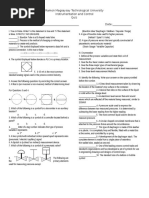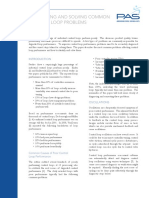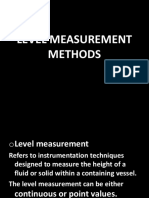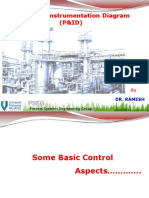Instrumentation and Controls
Uploaded by
xylan017Instrumentation and Controls
Uploaded by
xylan017Control of the processes in the plant is an essential part of the plant operation.
Parameters to be controlled: The Pressure The Flow The Temperature The Level
Setpoint (SP) - predetermined level
Identify the variables: The controlled variable - in our example this will be level. The manipulated variable - the inflow or outflow from the system.
Control action is only necessary when a difference or error exists between the setpoint and the measured level. The error will always take the form of: Error = Setpoint - Measured Quantity OR e = SP M
This concept justifies the use of the word negative in three ways: The negative aspect of feeding the measured signal backwards from the output to the input of the system. (Actual definition of negative feedback control).
The control correction must be negative in that a correction rather than a compounding of error must occur. The fact that an error must occur before a correction can take place, i.e., retrospective or negative control action. In the next section we will study in more detail the methods used to effect the necessary control corrections.
If we wish to control our process without an error first occurring, we must base our control on correction of the disturbances, which will eventually, cause a process error. This is termed feedforward control. Feedforward control is rarely if ever used on its own but is used in conjunction with feedback control to improve the response of control to process disturbances.
Typical On/Off Control Scheme The pressure at the switch will be P1 = gh1. - the mass density of the liquid g - the acceleration due to gravity h1 - the height of the liquid
The sinusoidal cycling is typical of on/off control. on/off control can be used to advantage on a sluggish system, i.e., where the periodic time is large.
If the outflow (Qo) increases then the level in the tank will fall. The pressure sensed by the level transmitter, which is representative of the level in the tank, will also fall causing a decrease in the output signal from the level transmitter. This output signal is fed to the (air to close) control valve (valve fully open with 20 kPa signal, fully closed with 100 kPa signal).
A falling level will therefore cause the valve to progressively open and hence raise the level in the tank. The system as shown is somewhat impractical as the initial setpoint conditions will need to be set by some manual method and then ensuring that steady state conditions are achieved with the valve at, say 50% opening and a level transmitter output of 60 kPa (50% range).
Example 1 A tank has inflow and outflow equal to 50% of maximum and its level is at the setpoint, say 50%. A step change in outflow occurs to 60% (+10%). Outflow now exceeds inflow so the level will fall. The output from the level transmitter will also fall and, for our system, will match the fall in level . say 1% change in signal for a 1% change in level. The LT signal will open the A/C valve more, by 1% in fact. The inflow is now 51%, still less than the outflow. The level will continue to fall until inflow equals outflow, i.e., (60%). This can only happen when the LT signal has changed by 10%) and this change reflects a drop in level on 10%: i.e., 10% offset.
To restore the process to the setpoint requires a further increase of inflow. This increase can only be achieved by a further decrease in signal to the valve .
With the conditions as stated in the example there is no way in which a 50% level can be achieved with a 60% outflow. A 50% level with a 60% outflow requires a 60% inflow. Our systems can only provide a 60% inflow from a 40% level signal.
Example 2 An alternative method of illustrating proportional control is by means of a simple float system (Figure 6). Assume the inflow and outflow are equal and the level is at the setpoint. If an increase in outflow occurs the level in the tank must fall. The float will also fall as the level falls. This drop in float position will cause the valve on the inflow to open more thus increasing the inflow. Eventually the fall in level will result in a valve opening, which will restore the mass balance between the inflow and the outflow.
Note an increased inflow can only be achieved as a result of a lower level in the tank. The level is no longer at the setpoint an offset has been generated.
3.4.1 Terminology
3.4.2 Practical Proportional The level controller will perform this function and is termed an indirect or reverse acting () controller. Then this reversal would not have been required and a direct () acting controller could have been used.
Control
It can be seen that a step increase in demand (outflow) has occurred at time t0. the resulting control correction has caused a new mass balance to be achieved after some time t1. At this time, under the new mass balance conditions, the level will stabilize at some level below the original setpoint, i.e., an offset has occurred, the loss in volume being represented by the shaded area between the input and output
Consider now the same demand disturbance but with the control signal increased in relative magnitude with respect to the error signal; i.e., instead of control signal = error signal, control signal = error signal x gain constant (k). Clearly for any given error signal the control signal will be increased in magnitude, the inflow will be increased, and a new mass balance will be achieved in a shorter time as shown in Fig. 9.
Gain can be defined as the ratio between change in output and change in input.
By inspection it can be seen that a PB of 100% is the same as a gain of one since change of input equals change in output. PB is the reciprocal of gain, expressed as a percentage. The general relationship is:
Example: What is the gain of a controller with a PB of? a) 40%, b) 200%
What will the PB setting in percent for a controller with gain of? a) 3, b) 0.4
Small values of PB (high gain) are usually referred to as narrow proportional band whilst low gain is termed wide proportional band. Note there is no magic figure to define narrow or wide proportional band, relative values only are applicable, for example, 15% PB is wider than 10% PB, 150% PB is narrower than 200% PB. We have seen from the two earlier examples that increasing the gain, (narrowing the PB) caused the offset to be decreased.
With reference to Figure 10, consider a high gain system (say gain = 50, PB = 2%). Under steady state conditions with the process at the setpoint the inflow will have a constant value. This is usually taken to be a control signal of 50% for a proportional controller with the process at the setpoint. In other words we have a 50% control capability. With our high gain system it can be seen that the maximum control signal will be achieved with an error of =1% (control signal = gain x error). This control signal will cause the valve to go fully open, the level will rise and the process will cross the setpoint.
Recall the output of a proportional controller is equal to:
For the purposes of this course we will assume the steady state output of a proportional controller when at the setpoint to be 50%. The equation for proportional control becomes:
Example: An air to open valve on the inflow controls level in a tank. When the process is at the setpoint the valve opening is 50%. An increase in outflow results in the valve opening increasing to a new steady state value of 70%. What is the resulting offset if the controller PB is: a) 50% b) 25%
Answer: To achieve correct control the controller will be reverse () acting. a) PB = 50% gain = 2 Change in valve position = 70 - 50 = 20% This is the output change from the controller
Since controller is reverse acting D measured variable must have been negative, i.e., -10%. This is equal to a + error or a . offset. offset = - 10% below setpoint.
Note that the narrower PB is likely to introduce some degree of oscillation into the system. Hopefully this will be a damped oscillation.
Thank
You for Listening!!!
God bless us all!!!
You might also like
- Advanced Temperature Measurement and Control, Second EditionFrom EverandAdvanced Temperature Measurement and Control, Second EditionNo ratings yet
- CO - Instrumentation & Control MIT, MANIPALNo ratings yetCO - Instrumentation & Control MIT, MANIPAL16 pages
- Instrumentation Basics - 03 - Level Measurement100% (1)Instrumentation Basics - 03 - Level Measurement63 pages
- Instrumentation Basics - 01 - Pressure Measurement100% (1)Instrumentation Basics - 01 - Pressure Measurement47 pages
- Process Control - Instrumentation and Control Engineering Interview QuestionsNo ratings yetProcess Control - Instrumentation and Control Engineering Interview Questions11 pages
- Instrumentation & Process Control Fundamentals: Designed By: Hossam A. HassaneinNo ratings yetInstrumentation & Process Control Fundamentals: Designed By: Hossam A. Hassanein39 pages
- Level Measurement: By: Ramir M. Salenga Bataan Peninsula State University100% (1)Level Measurement: By: Ramir M. Salenga Bataan Peninsula State University56 pages
- SIP-SOP02-R0-2017 SOP Differential Pressure Transmitter Calibration100% (1)SIP-SOP02-R0-2017 SOP Differential Pressure Transmitter Calibration3 pages
- Ramon Magsaysay Technological University Instrumentation and Control Quiz Name: DateNo ratings yetRamon Magsaysay Technological University Instrumentation and Control Quiz Name: Date2 pages
- Diagnosing and Solving Common Control Loop ProblemNo ratings yetDiagnosing and Solving Common Control Loop Problem9 pages
- Analog and Digital Signals - Electrical Instrumentation SignalsNo ratings yetAnalog and Digital Signals - Electrical Instrumentation Signals3 pages
- Lecture 10 - Multiple Control Loops - 2023No ratings yetLecture 10 - Multiple Control Loops - 202326 pages
- Lec1.0 - Introduction To Instrumentation & Its ApplicationsNo ratings yetLec1.0 - Introduction To Instrumentation & Its Applications54 pages
- Industrial Instrumentation & Control Basics100% (5)Industrial Instrumentation & Control Basics70 pages
- Process Instrumentation Basic DefinitionsNo ratings yetProcess Instrumentation Basic Definitions49 pages
- Instrument Selection, Installation ProceduresNo ratings yetInstrument Selection, Installation Procedures38 pages
- Electric Power Generation, Transmission & Distribution Revenues World Summary: Market Values & Financials by CountryFrom EverandElectric Power Generation, Transmission & Distribution Revenues World Summary: Market Values & Financials by CountryNo ratings yet
- Proportional Controller Principle and Other TopicsNo ratings yetProportional Controller Principle and Other Topics180 pages
- Control Actions: Two Step Control ActionNo ratings yetControl Actions: Two Step Control Action6 pages
- Control Actions: Two Step Control ActionNo ratings yetControl Actions: Two Step Control Action4 pages
- Process Dynamics, Optimization and ControlNo ratings yetProcess Dynamics, Optimization and Control15 pages
- BT - Module 2 - OSHE - Assignment Brief and Guide - Jan 2023No ratings yetBT - Module 2 - OSHE - Assignment Brief and Guide - Jan 202317 pages
- Rejection and Compensation of Periodic Disturbance in Control SystemsNo ratings yetRejection and Compensation of Periodic Disturbance in Control Systems11 pages
- Development of Improved Pid Controller For Single-Effect Evaporator100% (1)Development of Improved Pid Controller For Single-Effect Evaporator4 pages
- Process & Instrumentation Diagram (P&ID)No ratings yetProcess & Instrumentation Diagram (P&ID)66 pages
- Assignment Brief and Guide Module 2 - Essay - Sep 2022 (3) - 1No ratings yetAssignment Brief and Guide Module 2 - Essay - Sep 2022 (3) - 15 pages
- Universal Process Controller, / Din: Controlmaster Cm50No ratings yetUniversal Process Controller, / Din: Controlmaster Cm5024 pages
- Dokumen - Tips Coordinated Master Control in Thermal Power PlantNo ratings yetDokumen - Tips Coordinated Master Control in Thermal Power Plant40 pages
- BTM - Assignment Brief and Guide Module 2 - OSHE - Assessment - 3000 Word June 2023No ratings yetBTM - Assignment Brief and Guide Module 2 - OSHE - Assessment - 3000 Word June 202311 pages
- Feed Forward Control System, Organizational Learning and Business Unit PerformanceNo ratings yetFeed Forward Control System, Organizational Learning and Business Unit Performance5 pages
- Advanced Temperature Measurement and Control, Second EditionFrom EverandAdvanced Temperature Measurement and Control, Second Edition
- Instrumentation Basics - 01 - Pressure MeasurementInstrumentation Basics - 01 - Pressure Measurement
- Process Control - Instrumentation and Control Engineering Interview QuestionsProcess Control - Instrumentation and Control Engineering Interview Questions
- Instrumentation & Process Control Fundamentals: Designed By: Hossam A. HassaneinInstrumentation & Process Control Fundamentals: Designed By: Hossam A. Hassanein
- Level Measurement: By: Ramir M. Salenga Bataan Peninsula State UniversityLevel Measurement: By: Ramir M. Salenga Bataan Peninsula State University
- SIP-SOP02-R0-2017 SOP Differential Pressure Transmitter CalibrationSIP-SOP02-R0-2017 SOP Differential Pressure Transmitter Calibration
- Ramon Magsaysay Technological University Instrumentation and Control Quiz Name: DateRamon Magsaysay Technological University Instrumentation and Control Quiz Name: Date
- Diagnosing and Solving Common Control Loop ProblemDiagnosing and Solving Common Control Loop Problem
- Analog and Digital Signals - Electrical Instrumentation SignalsAnalog and Digital Signals - Electrical Instrumentation Signals
- Lec1.0 - Introduction To Instrumentation & Its ApplicationsLec1.0 - Introduction To Instrumentation & Its Applications
- Electric Power Generation, Transmission & Distribution Revenues World Summary: Market Values & Financials by CountryFrom EverandElectric Power Generation, Transmission & Distribution Revenues World Summary: Market Values & Financials by Country
- Proportional Controller Principle and Other TopicsProportional Controller Principle and Other Topics
- BT - Module 2 - OSHE - Assignment Brief and Guide - Jan 2023BT - Module 2 - OSHE - Assignment Brief and Guide - Jan 2023
- Rejection and Compensation of Periodic Disturbance in Control SystemsRejection and Compensation of Periodic Disturbance in Control Systems
- Development of Improved Pid Controller For Single-Effect EvaporatorDevelopment of Improved Pid Controller For Single-Effect Evaporator
- Assignment Brief and Guide Module 2 - Essay - Sep 2022 (3) - 1Assignment Brief and Guide Module 2 - Essay - Sep 2022 (3) - 1
- Universal Process Controller, / Din: Controlmaster Cm50Universal Process Controller, / Din: Controlmaster Cm50
- Dokumen - Tips Coordinated Master Control in Thermal Power PlantDokumen - Tips Coordinated Master Control in Thermal Power Plant
- BTM - Assignment Brief and Guide Module 2 - OSHE - Assessment - 3000 Word June 2023BTM - Assignment Brief and Guide Module 2 - OSHE - Assessment - 3000 Word June 2023
- Feed Forward Control System, Organizational Learning and Business Unit PerformanceFeed Forward Control System, Organizational Learning and Business Unit Performance

























































































